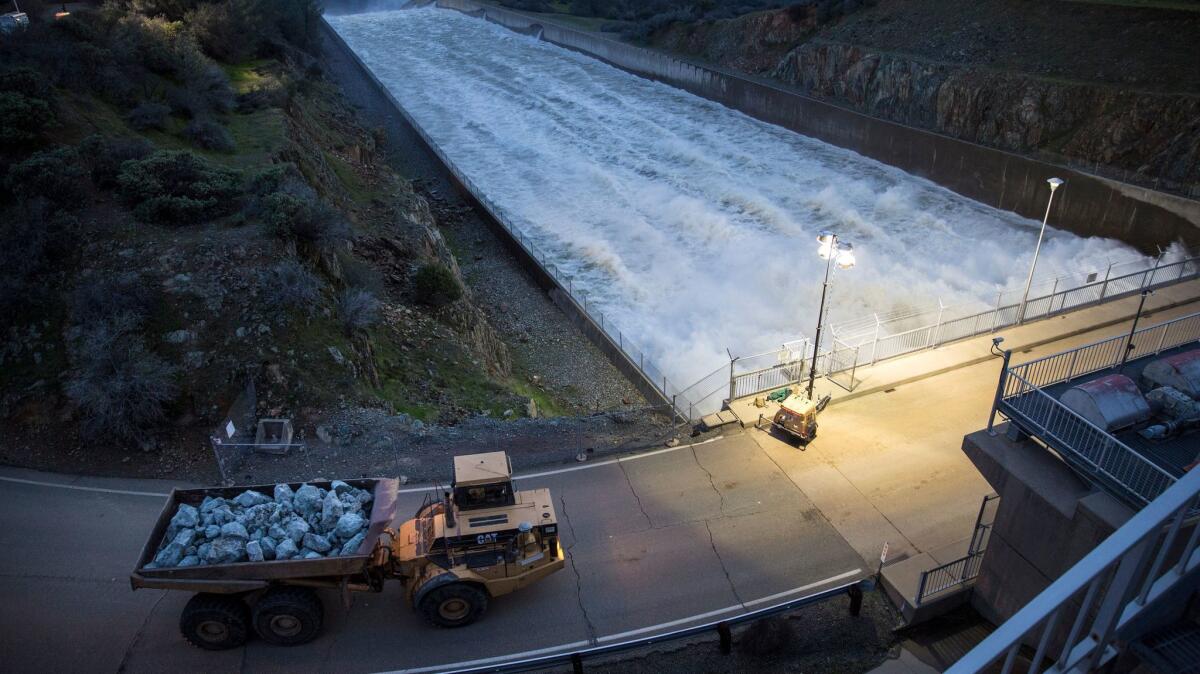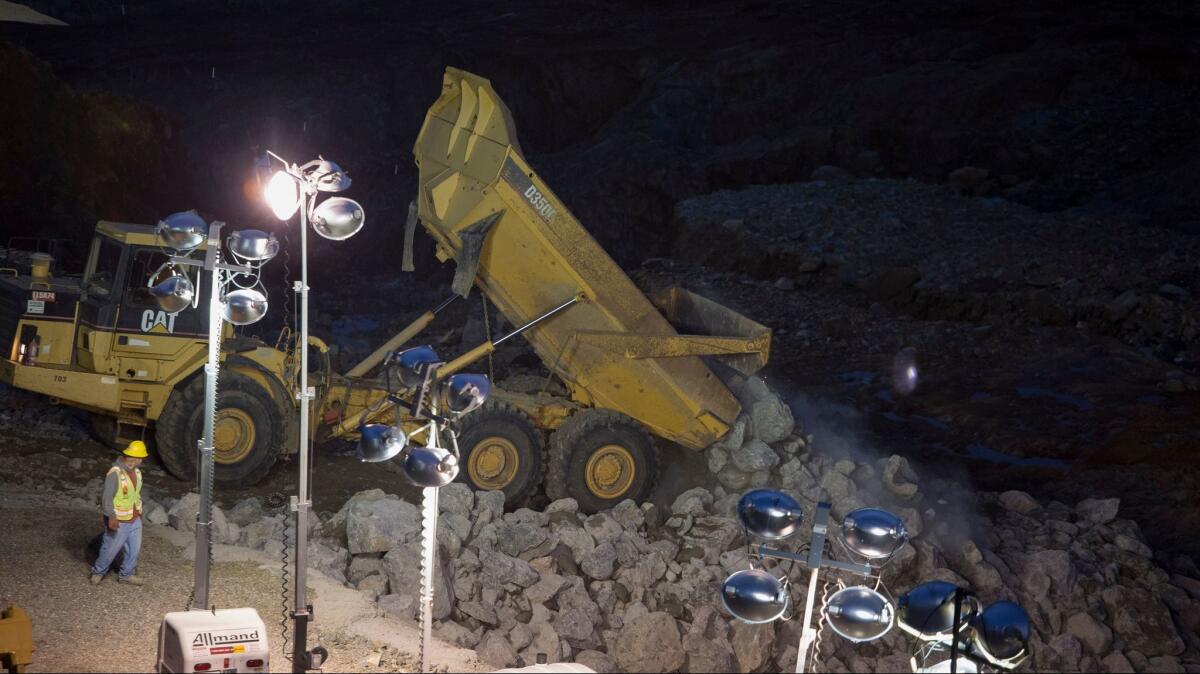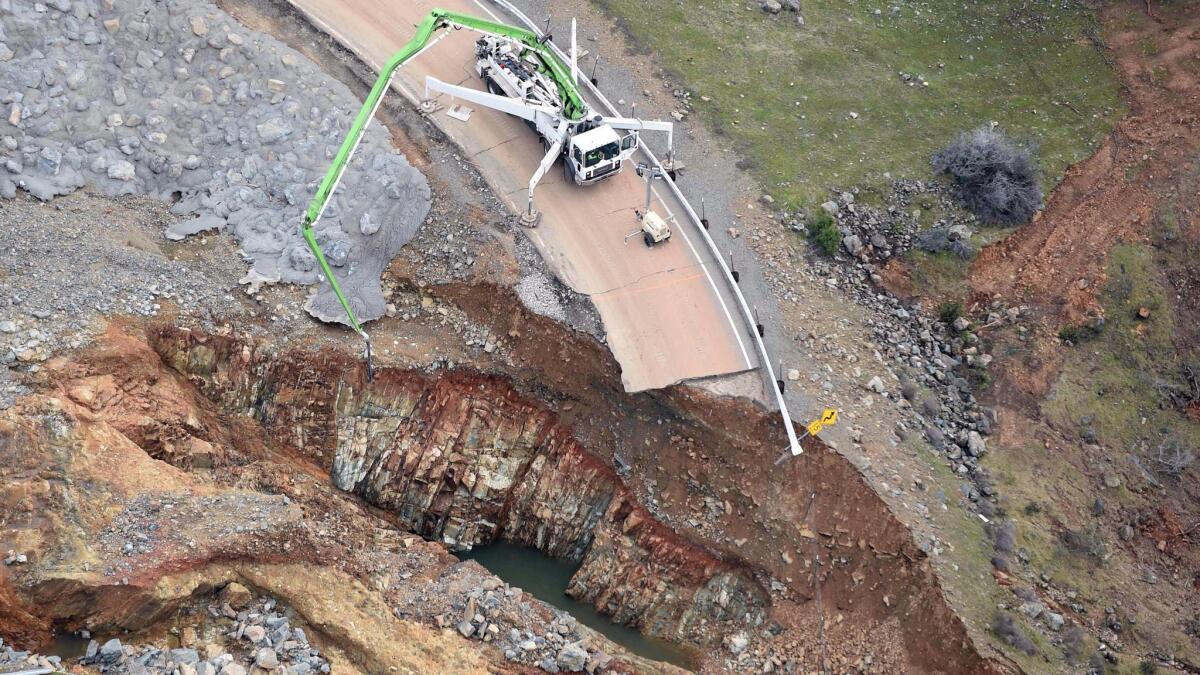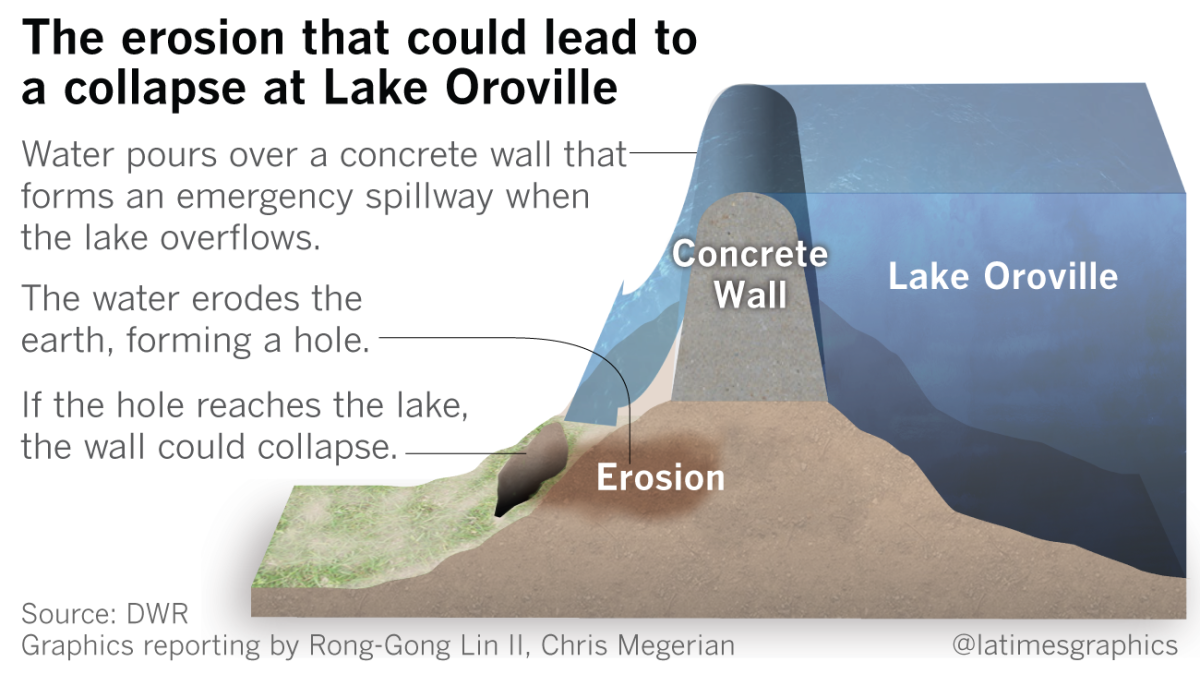Inside the desperate battle to shore up the eroded hillside next to Lake Oroville

Evacuees from the Oroville spillway crisis hear the evacuation order being lifted in Bangor. (Brian van der Brug / Los Angeles Times)
- Share via
Reporting from oroville, calif. — Armed with rocks and concrete, officials have been battling to fortify an earthen hillside next to Lake Oroville that has eroded — a critical task in case the reservoir overflows again.
A quarry is being worked around the clock to produce boulders that are being used in a desperate attempt to plug unexpected holes caused by erosion from water overflowing from the lake.
The fear is that if Lake Oroville, California’s second largest reservoir, starts spilling over in the coming days, weeks or months, water again will pour down this hillside and create further erosion, carving fissures into the slope and removing chunks of earth.
That could again chew away land that leads to the base of the concrete barrier along the edge of the lake, and a catastrophic failure could send a 30-foot wall of water down the Feather River, the largest tributary to California’s longest river, the Sacramento.
The crisis this week caused authorities to order evacuations of more than 100,000 people in three California counties: Butte, Yuba and Sutter.
Trucks have been dumping boulders — some as big as 4 to 6 tons — to patch some areas of the hillside, while helicopters have been dropping sacks of rocks in another place. Workers are mixing in a concrete slurry to help seal and solidify the placed rocks.

“You’re putting rocks in a hole. Then you’re putting slurry in to solidify it,” said Chris Orrock, spokesman for the California Department of Water Resources. “When water comes down, it will hit that patch and roll off.”
And that’s important — keeping water away from vulnerable spots that eroded when overflowing reservoir waters rushed down this hillside.
A convoy operation of sorts was kicking into gear Tuesday. Quarries were being called into action, with one, Bangor Quarry, operating 24 hours a day to produce boulders as heavy as 6 tons, with trucks in the morning coming in every few minutes to load up.
From there, rocks arrived at a lot just south of Oroville Dam. Rocks then were available for two operations. Yellow dump trucks hauled boulders over the dam and dumped them into eroded pockets of the hillside. Helicopters plucked sacks of rocks and deposited them on the far edge of the hill.
Workers transported a green pumper truck to inject concrete inside eroded hillside crevices. They also were building a gravel roadway in the bed of the eroded hill to reach other danger spots.
Some of the most visible efforts to shore up the hillside were just below a low concrete retaining wall, or weir, designed to be the last, best defense for an overflowing Lake Oroville. It’s designed to hold Lake Oroville to its maximum height. If the lake flows over the brim, water would travel over this concrete wall, known as the emergency spillway, onto the hillside.
This past weekend was the first time the emergency spillway had been used since Oroville Dam, the nation’s tallest, was completed in 1968.

By late Sunday, the immediate crisis was averted when officials decided they had no other choice than to lean harder on the crippled main spillway, a concrete chute that had been operating at reduced capacity because of its own partial disintegration. Luckily, the damaged main spillway was able to withstand the increased flows of water, and lake levels have been lowering since Sunday night.
On Tuesday afternoon, officials downgraded the evacuation order to a warning.
The game plan is to keep water behind the Oroville Dam below what its engineering designs call “flood control storage.” At that depth, the dam would have a buffer capacity of half a million acre-feet of water.
At the current release rate, a pounding 100,000 cubic feet per second, the dam will reach that point by late Saturday, early Sunday, even with another rain system arriving Wednesday, said Bill Croyle, acting director of the state Department of Water Resources.
Croyle said he is certain of the integrity of the main spillway and the steep hillside used for emergency overflow. Even so, he said, “Our goal is to remove as much water from the reservoir [as needed] so we don’t have to use it.”
Currently, crews are dropping 40 truckloads of rock an hour on the eroded slope, a process Croyle said would continue despite his belief that the slope is now safe enough to use if needed.

Falling temperatures associated with this week’s approaching weather system will help, by lowering the elevation at which some of that precipitation falls as snow and is locked up until spring. But Croyle said that merely delays when the dam will be required to handle the melt from what has been a spectacular snow year.
He said state engineers are using cameras to monitor the damaged section of the spillway and also are watching it from above and by overhead flights. The current release of water creates a curtain that obscures most of the gaping hole that appeared earlier, but what is visible from the side suggests there has been no increase in the damaged area.
“It’s performing very well,” Croyle said.
Butte Sheriff Kory Honea said he would leave it to residents to decide for themselves whether to leave if rising water levels again force the use of the emergency spillway. He said he would order another evacuation only if something were to suggest the repaired slope was again deteriorating.
Croyle said the amount of water released from the dam during the crisis is a state record. Archived data from the state agency show water releases exceeding 150,000 cubic feet per second in 1997, leading to the failure of a levee on the Feather River downstream and the evacuation of communities for 22 days.

Times staff writers Megerian and St. John reported from Oroville, Calif., Rañoa from Los Angeles, and Lin from San Francisco. Times staff photographer Brian van der Brug contributed from Oroville, Calif.
ALSO
L.A. area braces for what could be biggest storm of the season; flooding, mudslides possible
Trump approves FEMA disaster declaration for 34 California counties hit by storms
More to Read
Sign up for Essential California
The most important California stories and recommendations in your inbox every morning.
You may occasionally receive promotional content from the Los Angeles Times.














